

The Odeon is a small 500-seat theatre in Amman, Jordan. Not to be confused with the large Roman Theatre that stands right next to it, on the southern side of the Hashemite Plaza, while the Odeon stands on the east side of the Plaza.


The Odeon is a small 500-seat theatre in Amman, Jordan. Not to be confused with the large Roman Theatre that stands right next to it, on the southern side of the Hashemite Plaza, while the Odeon stands on the east side of the Plaza.
Archaeologists have speculated that the Odeon was most likely closed by a temporary wooden roof that shielded the audience from the weather. [1] [2] [3]
The building is a Roman odeon, built in the 2nd century CE, at the same time as the Roman Theatre next to it. [1] [3] [2]
The Odeon was recently restored along with the nearby Nymphaeum fountain. [1] [3] [2]
The Odeon is used nowadays for concerts, the most popular being the annually held Al-Balad Music Festival. [1] [3] [2]
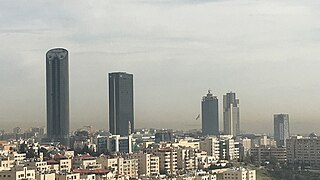
Amman is the capital and the largest city of Jordan, and the country's economic, political, and cultural center. With a population of 4,061,150 as of 2021, Amman is Jordan's primate city and is the largest city in the Levant region, the fifth-largest city in the Arab world, and the tenth-largest metropolitan area in the Middle East.

AMC Entertainment Holdings, Inc. is an American movie theater chain founded in Kansas City, Missouri, and now headquartered in Leawood, Kansas. It is the largest movie theater chain in the world. Founded in 1920, AMC has the largest share of the U.S. theater market ahead of Regal and Cinemark Theatres.

The Upright Citizens Brigade Theatre is an American improvisational theatre company and training center founded by the Upright Citizens Brigade troupe members Matt Besser, Amy Poehler, Ian Roberts and Matt Walsh.

Odeon may refer to:

The Odeon of Herodes Atticus is a stone Roman theatre structure located on the southwest slope of the Acropolis of Athens, Greece. The building was completed in AD 161 and then renovated in 1950.

Gortyna was a town of ancient Crete which appears in the Homeric poems under the form of Γορτύν; but afterwards became usually Gortyna (Γόρτυνα). According to Stephanus of Byzantium it was originally called Larissa (Λάρισσα) and Cremnia or Kremnia (Κρήμνια).

Approximately 100 years after the destruction of Punic Carthage in 146 BC, a new city of the same name was built on the same land by the Romans in the period from 49 to 44 BC. By the 3rd century, Carthage had developed into one of the largest cities of the Roman Empire, with a population of several hundred thousand. It was the center of the Roman province of Africa, which was a major breadbasket of the empire. Carthage briefly became the capital of a usurper, Domitius Alexander, in 308–311. Conquered by the Vandals in 439, Carthage served as the capital of the Vandal Kingdom for a century. Re-conquered by the Eastern Roman Empire in 533–534, it continued to serve as an Eastern Roman regional center, as the seat of the praetorian prefecture of Africa. The city was sacked and destroyed by Umayyad Arab forces after the Battle of Carthage in 698 to prevent it from being reconquered by the Byzantine Empire. A fortress on the site was garrisoned by Muslim forces until the Hafsid period, when it was captured by Crusaders during the Eighth Crusade. After the withdrawal of the Crusaders, the Hafsids decided to destroy the fortress to prevent any future use by a hostile power. Roman Carthage was used as a source of building materials for Kairouan and Tunis in the 8th century.
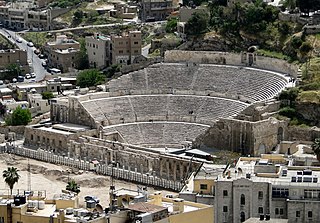
Roman Theatre of Amman is a 6,000-seat, 2nd-century Roman theatre. A famous landmark in the Jordanian capital, it dates back to the Roman period when the city was known as Philadelphia. The theatre and the nearby Odeon are flanking the new Hashemite Plaza from the south and the east respectively, while the Roman Nymphaeum is just a short stroll away in north-westerly direction.
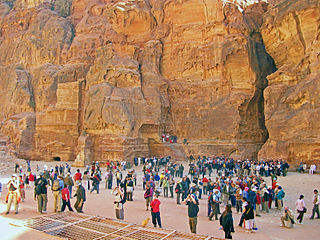
Jordan is a sovereign Arab state in the Middle East. The capital, Amman, is Jordan's most populous city as well as the country's economic, political and cultural centre.

Downtown Amman is an old, central commercial area of Amman, Jordan.

The Odeon of Lyon is a small ancient Roman theatre near the summit of the Fourvière hill in Lyon, France. It forms a pair with the Ancient Theatre of Fourvière, one of only two such pairs in Gaul. Along with other buildings in Lyon, it was inscribed on the UNESCO World Heritage List in 1998, protecting Lyon's long history as a powerful city and its unique architecture.
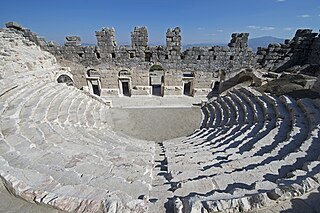
Cibyra or Kibyra, also referred to as Cibyra Magna, was an Ancient Greek city near the modern town of Gölhisar, in Burdur Province. It lay outside the north-western limits of the ancient province of Lycia and was the chief city of an independent state known as Cibyratis. Since 2016 it has been included in the Tentative list of World Heritage Sites in Turkey.
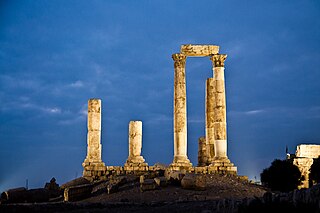
Temple of Hercules is a historic site in the Amman Citadel in Amman, Jordan. It is thought to be the most significant Roman structure in the Amman Citadel. According to an inscription the temple was built when Geminius Marcianus was governor of the Province of Arabia, in the same period as the Roman Theater in Amman.

The Nymphaeum is a partially preserved Roman public fountain in Amman, Jordan. It is located a short distance from the Hashemite Plaza, the Roman Theater and the Odeon, at the crossing of Ibn al-Atheer and Quraysh streets in al-Balad. Such fountains were very popular in Roman cities, and Philadelphia, as Amman was known by ancient Greeks and Romans, was no exception. This nymphaeum is believed to have contained a 600 square meters pool which was three meters deep and was continuously refilled with water.
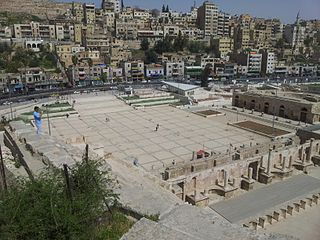
The Hashemite Plaza is a plaza in Amman, Jordan that spans over an area of 20,000 square metres. It was renewed in 2014 and is named after the Jordanian royal family, the Hashemites.

The theatre area of Pompeii is located in the southwest region of the city. There are three main buildings that make up this area: the Large Theatre, the Odeon, and the Quadriporticum. These served as an entertainment and meeting centre of the city. Pompeii had two stone theatres of its own nearly two decades before the first permanent stone theatre was erected in Rome in the 50s BC.
Alexandru Dabija is a stage director and actor in Romanian theater and film.

Jeffrey S. Gould Plaza is an outdoor campus plaza located on West 4th Street that is the home of several New York University (NYU) schools. It was named after NYU trustee Jeffrey S. Gould, and is also the namesake for the NYU welcome center of the same name. Surrounding the Plaza are the buildings of the Stern School of Business, Courant Institute of Mathematics, the economics department of NYU College of Arts and Science, NYU's Student Health Center, NYU's admissions center, Goddard Hall, Warren Weaver Hall, NYU's External Affairs building, and the Frederick Loewe Theatre.